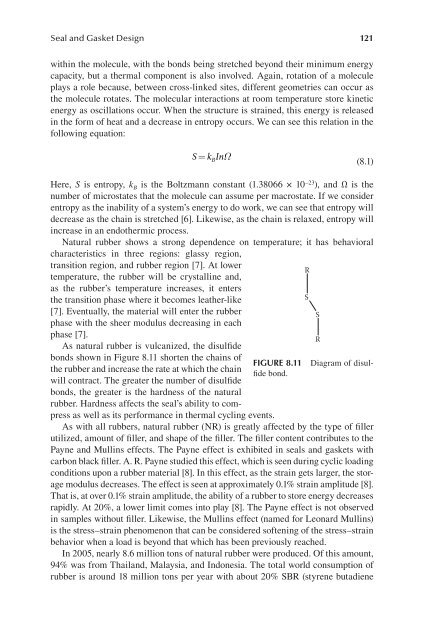THE ROLE OF THE
THE ROLE OF THE
THE ROLE OF THE
You also want an ePaper? Increase the reach of your titles
YUMPU automatically turns print PDFs into web optimized ePapers that Google loves.
Seal and Gasket Design 121<br />
within the molecule, with the bonds being stretched beyond their minimum energy<br />
capacity, but a thermal component is also involved. Again, rotation of a molecule<br />
plays a role because, between cross-linked sites, different geometries can occur as<br />
the molecule rotates. The molecular interactions at room temperature store kinetic<br />
energy as oscillations occur. When the structure is strained, this energy is released<br />
in the form of heat and a decrease in entropy occurs. We can see this relation in the<br />
following equation:<br />
S= kBInΩ (8.1)<br />
Here, S is entropy, k B is the Boltzmann constant (1.38066 × 10 –23 ), and Ω is the<br />
number of microstates that the molecule can assume per macrostate. If we consider<br />
entropy as the inability of a system’s energy to do work, we can see that entropy will<br />
decrease as the chain is stretched [6]. Likewise, as the chain is relaxed, entropy will<br />
increase in an endothermic process.<br />
Natural rubber shows a strong dependence on temperature; it has behavioral<br />
characteristics in three regions: glassy region,<br />
transition region, and rubber region [7]. At lower<br />
temperature, the rubber will be crystalline and,<br />
as the rubber’s temperature increases, it enters<br />
the transition phase where it becomes leather-like<br />
[7]. Eventually, the material will enter the rubber<br />
phase with the sheer modulus decreasing in each<br />
phase [7].<br />
As natural rubber is vulcanized, the disulfide<br />
bonds shown in Figure 8.11 shorten the chains of<br />
the rubber and increase the rate at which the chain<br />
will contract. The greater the number of disulfide<br />
bonds, the greater is the hardness of the natural<br />
rubber. Hardness affects the seal’s ability to compress<br />
as well as its performance in thermal cycling events.<br />
As with all rubbers, natural rubber (NR) is greatly affected by the type of filler<br />
utilized, amount of filler, and shape of the filler. The filler content contributes to the<br />
Payne and Mullins effects. The Payne effect is exhibited in seals and gaskets with<br />
carbon black filler. A. R. Payne studied this effect, which is seen during cyclic loading<br />
conditions upon a rubber material [8]. In this effect, as the strain gets larger, the storage<br />
modulus decreases. The effect is seen at approximately 0.1% strain amplitude [8].<br />
That is, at over 0.1% strain amplitude, the ability of a rubber to store energy decreases<br />
rapidly. At 20%, a lower limit comes into play [8]. The Payne effect is not observed<br />
in samples without filler. Likewise, the Mullins effect (named for Leonard Mullins)<br />
is the stress–strain phenomenon that can be considered softening of the stress–strain<br />
behavior when a load is beyond that which has been previously reached.<br />
In 2005, nearly 8.6 million tons of natural rubber were produced. Of this amount,<br />
94% was from Thailand, Malaysia, and Indonesia. The total world consumption of<br />
rubber is around 18 million tons per year with about 20% SBR (styrene butadiene<br />
R<br />
S<br />
FIgure 8.11 Diagram of disulfide<br />
bond.<br />
S<br />
R







